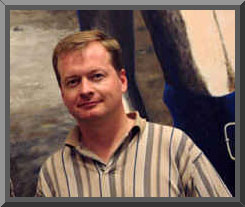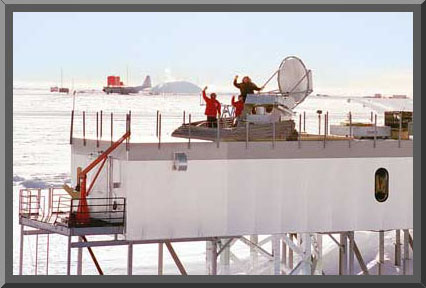| |

Simon Balm, Ph.D.
South Pole
Antarctica |
|

Antarctic Submillimeter Telescope and
Remote
Observatory |
|
| |
|
|
|
|
Contact information
e-mail
balm_simon@smc.edu
.
website
http://homepage.smc.edu/balm_simon/
.
Locator Map
http://www.frappr.com/apppublic
Level of accuracy: region of South Pole
Biography
Dr. Simon P. Balm originally from London,
England now lives in Santa Monica, California. He received his
Batchelor of Science degree in Chemistry from the University of Durham in
1988 and his Ph.D. in Chemical Physics from the University of Sussex in
1992. While at Sussex he did research on Carbon-60
(Buckminsterfullerene) for his adviser -- Sir Harry Kroto, Nobel Prize
winning chemist and co-discoverer of Carbon-60.
After graduate school he spent two years as a NATO Postdoctoral Fellow in
the UCLA astronomy Department followed by four years as a Postdoctoral
fellow at the Harvard-Smithsonian Center for Astrophysics in Cambridge, MA
where he helped to design, build and install a submillemeter radio telescope
at the geographical South Pole. He wintered-over with the telescope
at the Amundsen-Scott South Pole station during the 1996 austral winter.
After spending several years teaching as an Adjunct Professor at UCLA he
joined Santa Monica College as a full time faculty member in 2000 where he
is an Associate Professor of Astronomy.
Area of interest
Submillimeter imaging
.
Because of its exceptionally cold and dry atmosphere, the
South Pole is the best ground-based observatory site for astronomical
observations at submillimeter wavelengths. The scientific program is
currently focused on spectroscopic observations of atomic and molecular
clouds in the Milky Way and other galaxies.
Observing site
Amundsen-Scott South Pole station in Antarctica
Astronomical Equipment
.
AST/RO
(Antarctic Submillimeter Telescope and Remote Observatory)
ST/RO is a 1.7 meter diameter off-axis telescope for research in
astronomy and aeronomy at wavelengths between 200 and 2000 microns. The
instrument is now operating at the South Pole with four heterodyne
receivers and three acousto-optical spectrometers. The AST/RO telescope
was designed by Antony A. Stark of the Smithsonian Astrophysical
Observatory and fabricated between 1990 and 1992 at the Scientific
Instrument Facility at Boston University and at Bell Laboratories in
Holmdel, New Jersey. All the components of AST/RO were integrated and
installed at a test site at Boston University in 1993-94, where the system
was used for observations at 230 GHz and tests at 492 GHz (Stark et al.
1994). The telescope was installed on the roof of a dedicated support
building at Amundsen-Scott South Pole Station during the 1994-95 Austral
summer (Lane and Stark 1996). Astronomical observations commenced in March
1995. The optical and mechanical properties of the telescope are described
in detail in Stark et al. (1997). Other aspects of observatory operations
are described in
Stark et al.
(2001).
Optics
All of the optics in AST/RO are offset to produce high beam efficiency
and to avoid inadvertent reflections and resonances. The primary
reflector is made of carbon fiber and has an rms surface accuracy of
about 9 microns. In its current configuration, AST/RO has a Coude'
focus. The telescope also has a Nasmyth focus which is almost identical
in its optical properties to the bent Cassegrain focus on NASA's Kuiper
Airborne Observatory.
Receivers
There are currently four heterodyne receivers mounted on an optical
table suspended from the telescope structure in a spacious, warm Coude'
room:
-
"Major Dobbin" (230 GHz SIS receiver): 100 K DSB
noise temperature.
-
-
"Wanda" (dual 492/810 GHz SIS waveguide receiver):
460-492 GHz: 220 K DSB noise temperature; 800-820 GHz: 990 K DSB noise
temperature. (Walker et al. 1992; Honingh et al. 1997). Simultaneous
observations with the 2 mixers are possible, allowing concurrent
measurement of CO 4-3, CO 7-6, and the 809 GHz [CI] line (or
alternatively, the 492 GHz [CI] line, plus CO 7-6 and the 809 GHz [CI]
line).
-
-
"FLaMR" (460-492 GHz SIS quasi-optical receiver):
300 K DSB noise temperature (Zmuidzinas and LeDuc 1993; Engargiola,
Zmuidzinas, and Lo 1994).
-
-
"PoleSTAR" (an array of four 800-820 GHz fixed-tuned
SIS waveguide mixer receivers): 806-809 GHz: 900-950 K DSB noise
temperature (Walker et al. 2001).
Spectrometers
The spectrometers currently available are: two acousto-optical
spectrometers (AOS) with 1.07 MHz resolution, 1.1 GHz bandwidth, and
2048 channels each, and one high-resolution AOS with 44 kHz resolution,
64 MHz bandwidth, and 2048 channels (Schieder, Tolls, and Winnewisser
1989).
Operations
The entire AST/RO system is highly automated to reduce to a minimum the
need for human intervention. Observations during the Austral winter are
conducted by the AST/RO winterover scientist in residence at South Pole,
currently Dr. Chris Martin of Smithsonian Astrophysical Observatory.
During the Austral summer (November to early February), when
transportation to South Pole is once again possible, typically 15-17
AST/RO scientists visit the observatory to perform observations, install
new instrumentation, and maintain hardware and software. Additional
information about the system may be found in
AST/RO
Technical Memorandum #35.
from:
http://cfa-www.harvard.edu/%7Eadair/AST_RO/info.html
|